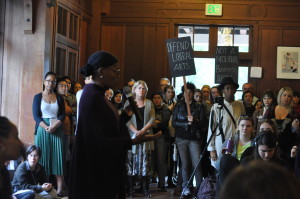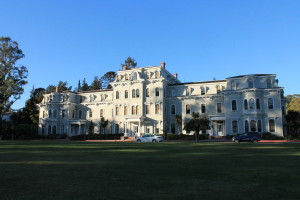
Dance majors, minors and graduate students have rallied in outrage this week against proposed cuts to their program.
The dance department, along with book art and American studies, is slated for massive cuts with the implementation of the proposed revisions for the Mills curriculum. According to the memorandum sent by President DeCoudreaux on Oct. 19, the dance minor and masters programs will be retained, but the major itself will be dissolved.
“If you get rid of the dance major, people aren’t going to come to the masters program,” first year dance MFA student Bhumi Patel said. “We need our undergraduates. We love having that community of people.”
Students in the dance department claim that many unique programs providing opportunities for students to perform and hone their skills, such as Studio One nights, Undergrad Underground, and the Repertory Dance Company, will fold without the support of undergraduate majors.
“Mills dance is giving undergraduate female identified persons opportunities. Real opportunities. To make work, to explore the discipline beyond the surface, and to really grow as conscientious artists,” Zachary Forcum, a second year dance MFA student, said.
The statement about the curriculum changes indicated that these changes were being made with the goal of creating programs that would distinguish Mills as a college. Mills is known as the home of the country’s oldest dance program, leaving many students wondering why it is so ready to undermine this distinguished title if national renown is the administration’s goal.
“How are we going to identify as a liberal arts college that has the oldest dance program in the country and let go of that as a major for students? How does that make us more competitive?” first year dance MFA Erik Lee said.
Many current students are attending Mills solely for its historic dance department. One of these students, senior dance major Mackenzie Pierson, notes that, though the program is comparatively small, Mills has done nothing to bolster its enrollment or popularity.
“The biggest thing [administrators] weren’t aware of is that in admissions they don’t advertise these programs,” Pierson said, referring to dance and book art, which are both slated for cuts. “They push programs that have more funding but that we’re not known for.”
Students like Pierson believe that advertising our historic programs and generating interest at local high schools may help increase the number of applicants to Mills, and help solve budgetary problems.
The cutting of the dance major will only result in the termination of a single class: the senior thesis class. This leads many students to believe that closing out the major will not even cut costs enough to improve the college’s financial situation in the long run. This, paired with administration’s claims, during a student forum on Wednesday, Oct. 21st, that the changes have more to do with bringing Mills into the 21st century than with cutting costs, has incited a great deal of confusion and frustration from dance students.
“I found it very difficult to perceive what was genuine from the administration and what was just political rhetoric,” second year MA dance student Abigail Keyes said. “It was really hard for me to figure out if what they were saying was really heartfelt or if it was just pacification, because it felt really patronizing.”
Despite claiming that these curriculum changes are aimed to give Mills students a 21st century education, they have neglected to give a definitive explanation of what they consider a “21st century education” to be.
“[This proposal] doesn’t consider how important the arts are to this notion of a 21st century education,” Patel said.
The administration has indicated that their concept of the new curriculum places great importance on making existing programs more interdisciplinary, but students in the dance program assert that their department already exists as a shining example of interdisciplinary study at Mills.
“This training isn’t just to become a dancer. Learning about dance changes the way you think,” Pierson said. “It trains you for a vast array of different jobs in a way that is more interdisciplinary, more connected than other art training.”
“It’s a lot more interdisciplinary than they give it credit for,” senior dance minor Sophia Klein said.
This sentiment is echoed across the dance department, graduate students speaking out on behalf of their undergraduate peers.
“People with BAs in dance go on to teach, go on to tech, go on to arts administration, go on to work in corporations, go on to start companies, go on to be choreographers, go on to be performers. They go on to be so many things because dance isn’t about just movement, it’s about discipline, it’s about working hard,” Patel said. “We were talking yesterday about the Mills mission statement, and if you replace ‘the college’ with ‘the dance department,’ that’s exactly what we’re doing here.”
Forcum pointed out the dwindling number of professional female choreographers as motivation enough for continuing to support the dance program at Mills, a college that has from the beginning prided itself on empowering women and giving them the skills to be competitive in any field.
“There are becoming less and less and less female choreographers,” Forcum said. “How are we going to create those artists if we don’t have that space in a college like this? How are we really serving the population?”
Dance students believe that there are plenty of ways to improve Mills’ financial standing without cutting its most historic and distinguished programs, from increasing awareness of these programs in high schools, to reaching out to the many tech companies and foundations that got their start in the Bay Area, to consulting with the faculty and creating a plan of action to generate revenue from the programs that already exist.
Students and Mills administration will continue to hold meetings about the cuts throughout the rest of the semester, allowing students to continue to make the case for retaining their programs.



